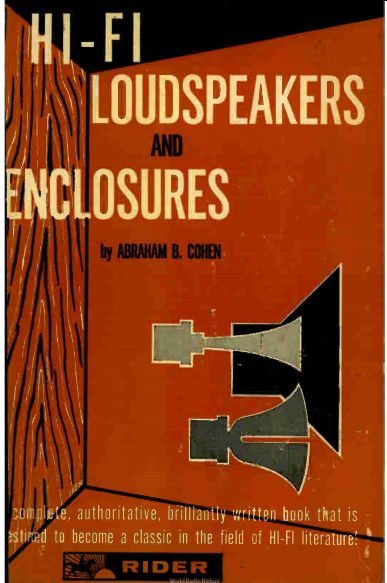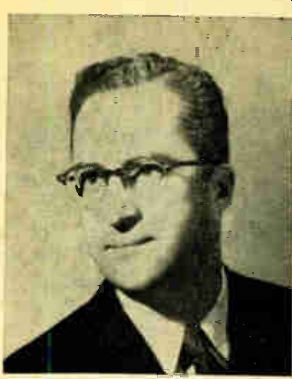CONTENTS:
PART 1: THE LOUDSPEAKER
Section 1: The Sound Circuit
Section 2: Basic Loudspeaker Types
Section 3: Hi-Fi Variations of Basic Loudspeaker Types
Section 4: The Mechanics of Good Hi-Fi Loudspeaker Design
Section 5: The Meaning of Loudspeaker Resonance, Impedance, & Damping
Section 6: Multi-Speaker System Design
Section 7: Networks in Multi-Speaker Systems
PART 2: THE ENCLOSURE
Section 8: Basic Enclosure Types
Section 9: The Enclosure Type Baffle
Section 10: Horn Type Enclosures
Section 11: The Combined Enclosure-Horn System
Section 12: Enclosure Size, Speaker Resonance, and System Response
Section 13: The Enclosure as a Crossover Element
Section 14: The Mechanics of Good Enclosure Design
PART 3: THE ROOM
Section 15: The Room as Part of the Acoustic Circuit
Section 16: Placing the Enclosure in the Room
Section 17: Adjusting the Room to Match the System
Section 18: Adjusting the System to Match the Ear
==============

This guide is based on the above book from 1956.
The many attempts to arrive at a rigid definition of high fidelity have all failed. They have failed for the simple reason that high fidelity is an art, and art defies formulation. The fact that nearly all high-fidelity program material is musical explains to a great extent why this art, once limited to the technician's domain, is now accepted by people in all walks of life.
No one is immune to music. We march to it, relax with it, are inspired by it, even rock and roll to it. It is this universal appeal that made success inevitable for any method of increasing the enjoyment of music in the home.
Because the writer considers high fidelity an art, he hesitates at proposing any all-embracing definition. It is our opinion that the use of such terms as "faithful," "realistic," and "lifelike" (and there is little agreement in defining these) can only be sanctioned on a relative basis.
True, compared to the quality of reproduction of twenty years ago, that of today is lifelike and realistic. But this is not enough. We must delve beyond technical excellence, beyond the concept of realism, to primarily artistic considerations. We must ask, for instance, how well the composer's intentions are served.
We have perhaps been so overawed by the relative realism of high fidelity sound reproduction that we have lost sight of the fact that the music undergoes many modifications, technical as well as artistic, be fore emerging as a finished recording. These modifications, along with those made by the listener through the adjustment of controls on the reproducing equipment, are the subject of the closing sections, with the emphasis on the personal factor, which ultimately dictates the choice of components. This personal factor is an essential element in our consideration of loudspeakers, enclosures, room acoustics, and hearing characteristics as interdependent factors in an integrated whole, the sound circuit. The elements in this circuit are described briefly in the opening section; then, after the reader has had a chance to acquire a working knowledge of the components, they are integrated in the final section.
The reader is taken in gradual steps from basic loudspeaker principles toward an understanding of the variations used in specialized high quality reproducers. In our discussion of enclosures, we apply the same method, proceeding from the simplest types to the most elaborate structures in use today.
We have attempted to provide a comprehensive treatment that should be useful both to the "do-it-yourself" enthusiast and to the purchaser of a packaged system. The information gathered here is intended as an aid to the former in designing and coordinating the system that best suits his needs; to the latter we offer a better understanding and appreciation of the functioning of his equipment.
We acknowledge our debt of gratitude to scores of people, specifically to the staff of University Loudspeakers, Inc. A decade or more of close association with them has been fruitful in developing what we hope is a well balanced approach to acoustic problems. To the worthy competitors we owe thanks for their kind cooperation in providing much of the material presented herein. Finally, we wish to thank Mr. Milton S. Snitzer, Managing Editor of John F. Rider Publisher, Inc., for his appreciative reading of the text and his clarifying comments and advice.
White Plains, N. Y. USA. ABRAHAM B. COHEN
March 1956

ABRAHAM B. COHEN --- Audio Engineer, Abraham B. Cohen, has been active
in music and music reproduction since his teens. During his high
school years he was Concertmaster of the Boston School Symphony Orchestra
and first violinist in the Boston Civic Symphony Orchestra. Although
his extra curricular interests lay in musical activities, his professional
goal was electrical engineering and in 1932 he received his BEE degree,
cum laude, from Northeastern University and his BS in electrical
engineering in 1933.
Upon graduation he became a member of radio station WCAU in Philadelphia where from 1934 through 1936 he served as studio control engineer. From 1936 through 1942, Mr. Cohen was a member of the Engineering Department of Westinghouse Broadcast Stations serving with radio station KYW in Philadelphia. He came to New York in 1942 as Chief Engineer for Metropolitan Television Inc. Following this, Mr. Cohen took the positions of Senior Acoustic Engineer with Best Manufacturing Co., Industrial Electronics Field Engineer with Radio Receptor Co., and then to University Loudspeakers in 1946 as Laboratory Supervisor where in 1953 he became Engineering Manager. In 1958 Mr. Cohen organized his own company, Advanced Acoustics Inc. He then formed a new company, Acoustic Developments Inc.
Mr. Cohen is a charter member of the Audio Engineering Society, a member of the Acoustical Society of America, and a member of the Institute of Radio Engineers. Mr. Cohen has twice served as Chairman of the Loud speakers Sections of the annual conventions of the Audio Engineering Society and is a member of the Electro-acoustical Committee of the Institute of Radio Engineers.
JOHN F. RIDER PUBLISHER, INC., NEW YORK, USA.
Also see: